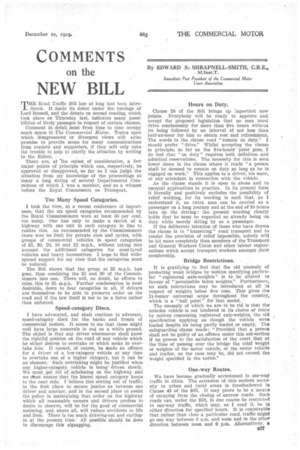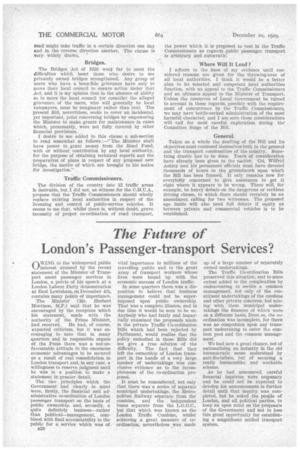COMMENTS
Page 63

Page 64

If you've noticed an error in this article please click here to report it so we can fix it.
on the
NEW BILL
By EDWARD S. SHRAPNELL-SMITH, C.B.E.,
M.Inst.T.
Immediate Past President of the Commercial Motor Users Association
THE Road Traffic Bill has at long last been introduced. It Made its debut Under the tutelage of Lord Russell, and the debate on second reading, which took place on Thursday last, indicates many possibilities of lively passages in respect of certain clauses.
Comment in detail must from time to time occupy much space in The Commercial Motor. Topics upon which disagreement or divergent views will arise promise to provide scope for many communications from readers and supporters, if they will only take the trouble to help to clarify the situation by writing to the Editor.
There are, at the outset of consideration, a few major points of principle which can respectively, be approved or disapproved, so far as I can judge the situation from my knowledge of the proceedings at many a long sitting of several Departmental Committees of which I was a member, and as a witness before the Royal Commission on Transport.
Too Many Speed Categories.
I took the view, at a recent conference of importance, that the six speed categories recommended by the Royal Commissioners were at least 50 per cent. to many. One has only to make a sketch of a highway with one unit in each category in line to realize this. As recommended by the Commissioners there was no limit for private cars and cycles, with groups of commercial vehicles in speed categories of 35, 30, 20, 16 and 12 m.p.h., without taking into account the additional categories for steel-tyred vehicles and heavy locomotives. I hope to find widespread support for my view that the categories must be reduced.
The Bill shows that She group at 35 m.p.h. has gone, thus combining the 35 and 30 of the Commissioners into one. There will, no doubt, be efforts to raise this to 35 m.p.h. Further condensation is most desirable, down to four categories in all, if drivers are themselves to be able to preserve order on the road and if the law itself is not to be a farce rather than enforced.
Speed-category Discs.
I have advocated, and shall continue to advocate, speed-category discs for the backs and fronts of commercial motors. It seems to me that these might well haye large numerals in red on a white ground. The object is that any driver whatsoever shall know the rightful position on the road of any vehicle which he either desir6s to overtake or which seeks to overtake him. It cannot, of course, be made an offence for a driver of a low-category vehicle at any time to overtake one of a higher category, but it can be an 'element. Such overtaking might be justified when any higher -category vehicle is -being driven slowly. We must, get rid of echeloning on the highway and we rust ensure that the lowest speed category keeps to the near side. I believe this sorting out of traffic, in the first place to secure justice as between one driver and another, and in the second place to assist the police in maintaining that order on the highway which all reasonable owners and drivers profess to desire to observe, will be for the good of commercial motoring, and, above all, will reduce accidents to life and limb. There is too much drawing-out and cuttingin at the present time. All possible should be done to discourage this zigzagging. Hours on Duty.
Clause 18 of the Bill brings up important new points. Everybody will be ready to approve and accept the proposed legislation that no man must drive continuously for more than five hours without its being followed by an interval of not less than half-an-hour for him to obtain rest and refreshment. The words in the clause read "remain on duty." I should prefer "drive." Whilst accepting the clause in principle, so far as the five-hours' point goes, I • do feel that "on duty" requires both definition and admitted reservations. The necessity for this is seen lower down in the clause where it reads "a person shall be deemed to remain on duty so long as he is engaged on work." This applies to a driver, his mate, or any attendant in connection with the vehicle.
As the clause stands it is open to abuse and to unequal applications in practice. In its present form it literally and positively excludes the possibility of relief working, for its wording is such that, as I understand it, no extra man can be carried as a passenger on a long journey and at the end of 10 hours take up the driving: the present wording clearly holds that he must be regarded as already being on duty while merely sitting by as a passenger.
If the deliberate intention of those who have drawn the clause is to "hamstring" road transport and to render the provision of relief impossible, nobody will• be hit more completely than members of the Transport and General Workers Union and other labour organizations which accept transport workers amongst their membership.
Bridge Restrictions.
It is gratifying to find that the old anomaly of protecting weak bridges by notices specifying particular "registered axle-weights" is to be altered in favour of "permissible laden weights." Furthermore, no such restrictions may be introduced at all in respect of weights below five tons. This gives the 21-tonner universal scope throughout the country, which is a "bull point" for that model.
The anomaly of which we are to be rid is that the unladen vehicle is not hindered in its choice of route by notices concerning registered axle-weights, the old specification applying as though the vehicle were loaded despite its being partly loaded or empty. The safeguarding clause reads: "Provided that a person shall not be guilty of an offence under this sub-section if he proves to the satisfaction of the court that at the 'time of passing over the bridge thc total weight or weights of the motor vehicle, or the motor vehicle and trailer, as the case may be, did not exceed the weight' specified in the notice."
One-way Routes.
We have become gradually accustomed to one-way traffic in cities. The extension of this modern necessity to urban and rural areas is foreshadowed in Clause 43 of the Bill. It may prove to be ft:means of escaping from the closing of narrow roads. Such roads can, under the Bill, in due course be restricted to one-way traffic, which may, as I read it, be in either direction for specified hours. It is conceivable that rather than close a particular road, traffic might go one way between 6 a.m, and noon and in the other direction between noon and 6 p.m. Alternatively. a road might take traffic in a certain direction one day and in the reverse direction another. The clause is very widely drawn. '
Bridges.
The Bridges Act of 1928 went far to meet the difficulties which beset those who desire to see privately owned bridges strengthened. Any group of users who have a bona-fide grievance have only to move their local council to ensure action under that ,Act, and it is my opinion that in the absence of ability so to move the local council (or councils) the alleged grievance of the users, who will generally be local ratepayers, must be imaginary rather than real. The present Bill, neverthless, seeks to cover an incidental, yet important, point concerning bridges by empowering the Minister to make, grants for maintenance in cases which, presumably, were not fully covered by other financial provisions,
I desire to see added to this clause a sub-section to read somewhat as follows The Minister shall have power to grant money from the Road Fund, with or without contribution by any local authority, for the purpose of obtaining technical reports and the preparation of plans in respect of any proposed new bridge, the merits of which are brought to his notice for investigation."
Traffic Commissioners.
The division of the country into 12 traffic areas Is desirable, but I did not, as witness for the C.M.U.A., propose that the Traffic Commissioners should wholly replace existing local authorities in respect of the licensing and control of public-service vehicles. It seems to me that, whilst there is, without doubt, grave necessity of proper co-ordination of road transport, the power which it is proposed to vest in the Traffic Commissioners as regards public passenger transport is arbitrary and autocratic.
Where Will It Lead ?'
I adhere to the lines of my evidence until considered reasons are given for the throwing-over of all local authorities. I think it would be a better plan to let selected and competent local authorities function, with an appeal to the Traffic Commissioners and an ultimate appeal to the Minister of Transport. Unless the resources of Local Government be turned to account in these regards, possibly with the requirement of concurrence by the Traffic Commissioners, we may have bottle-necked administration of the most harmful character, and I am sure these considerations will call for most careful exploration during the Committee Stage of the Bill.
General.
Taken as a whole the drafting of the Bill and its objectives must commend themselves both to the general and the transport communities of the country. Something drastic has to be done. Years of consideration have already been given to the matter. Col. Wilfrid Ashley and his permanent officials must have devoted thousands of hours to the groundwork upon which the Bill has been framed. it only remains now for everybdtly concerned to give assistance to get it right where it appears to be wrong. There will, for • example, be heavy debate on the dangerous or reckless driving clause, to which there should certainly be an amendment calling for two witnesses. The proposed age limits will also need full debate if equity as between private and commercial vehicles is to be established.
























































































































